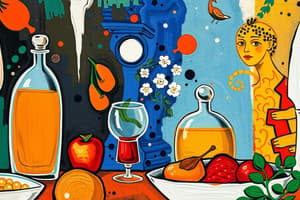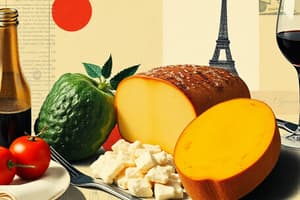Podcast
Questions and Answers
Which culinary movement developed in France during the 1970s and 80s?
Which culinary movement developed in France during the 1970s and 80s?
- Nouvelle cuisine (correct)
- Haute cuisine
- Molecular gastronomy
- Creole cuisine
Who first popularized the term 'gastronomy'?
Who first popularized the term 'gastronomy'?
- Cesar Ritz
- Marie-Antoine Carême
- August Escoffier
- Berchoux (correct)
What does the term 'gastronomy' specifically refer to?
What does the term 'gastronomy' specifically refer to?
- The nutritional values of food
- The styles and modes of cooking and eating habits (correct)
- The history of culinary arts
- The study of food chemistry
What term describes the textural quality of food?
What term describes the textural quality of food?
Which of the following factors does NOT affect odor identification?
Which of the following factors does NOT affect odor identification?
What happens to taste when smell is impaired?
What happens to taste when smell is impaired?
Who is known for establishing the French system of kitchen brigade management?
Who is known for establishing the French system of kitchen brigade management?
How many types of olfactory receptor cells are there?
How many types of olfactory receptor cells are there?
What does 'creolization' in contemporary gastronomy refer to?
What does 'creolization' in contemporary gastronomy refer to?
Which figure published 'De honesta voluptate' in 1450?
Which figure published 'De honesta voluptate' in 1450?
What shape do musky odor compounds have?
What shape do musky odor compounds have?
In gastronomy, what does 'haute cuisine' refer to?
In gastronomy, what does 'haute cuisine' refer to?
Which of the following best describes a floral odor compound?
Which of the following best describes a floral odor compound?
What does the term 'creole' refer to in the context of gastronomy?
What does the term 'creole' refer to in the context of gastronomy?
What is the effect of temperature on odors?
What is the effect of temperature on odors?
Which type of charge do putrid odors carry?
Which type of charge do putrid odors carry?
Which cooking method is primarily used for large pieces of tender meat in the oven?
Which cooking method is primarily used for large pieces of tender meat in the oven?
What kind of cooking method is broiling considered to be?
What kind of cooking method is broiling considered to be?
Which wine is suggested to be served with raw oysters due to its contrasting taste profile?
Which wine is suggested to be served with raw oysters due to its contrasting taste profile?
What do complementary taste components in food and wine pairing share?
What do complementary taste components in food and wine pairing share?
Which cooking method involves the use of meat drippings for deglazing?
Which cooking method involves the use of meat drippings for deglazing?
What taste component is commonly associated with astringency in dry red wines?
What taste component is commonly associated with astringency in dry red wines?
What is the cooking technique that typically reduces cooking time below 98°C?
What is the cooking technique that typically reduces cooking time below 98°C?
Which ingredient is noted for being umami-rich?
Which ingredient is noted for being umami-rich?
Which of the following is a psychological factor affecting odor identification?
Which of the following is a psychological factor affecting odor identification?
What are the qualitative characteristics used to evaluate the odor of a substance?
What are the qualitative characteristics used to evaluate the odor of a substance?
Which food category does NOT include raw foods?
Which food category does NOT include raw foods?
What aspect does the process of analyzing flavor NOT include?
What aspect does the process of analyzing flavor NOT include?
Cultural determinants of taste are significant mainly in which phase of development?
Cultural determinants of taste are significant mainly in which phase of development?
Which of these describes preserved foods?
Which of these describes preserved foods?
Which of the following factors is NOT considered a physiological factor in odor identification?
Which of the following factors is NOT considered a physiological factor in odor identification?
What characteristic is associated with processed foods?
What characteristic is associated with processed foods?
What is the most effective way to counterbalance a dish that is rich or fatty?
What is the most effective way to counterbalance a dish that is rich or fatty?
Which element is considered least important when making wine and food pairing decisions?
Which element is considered least important when making wine and food pairing decisions?
How does saltiness in food affect wine pairing?
How does saltiness in food affect wine pairing?
What type of wine should be served with bitter foods?
What type of wine should be served with bitter foods?
What is a key consideration when planning a menu for an event?
What is a key consideration when planning a menu for an event?
Flashcards are hidden until you start studying
Study Notes
Gastronomy
- "Gastronomy" derives from the Greek words "gastro" (stomach) and "nomy" (rules), referring to the rules governing the consumption of food.
- Coined by French writer Berchoux, it gained popularity in France after the French Revolution, representing the growing importance of cuisine in the new bourgeois society.
History of Gastronomy
- Key figures like Athenaeus, Apicius, and Bartolomeo de Sacchi di Piadena (Platina) contributed significantly to the understanding of fine dining.
- Platina's 1450 work "De honesta voluptate" highlights the early foundations of gastronomy.
- The development of Haute Cuisine (High Cuisine) marks the professionalization and codification of cooking and dining practices in the Western world.
- August Escoffier and Cesar Ritz significantly influenced the French kitchen brigade management system.
- "Nouvelle Cuisine" emerged in France during the 1970s and 1980s, marking a shift in culinary trends.
Contemporary Gastronomy
- Promotes hybrid creations and "creolization," where distinct cuisines blend to create new dishes.
- This is especially prevalent in post-colonial regions where indigenous cultures are reclaiming influence.
Mouthfeel
- Describes the textural sensation of food, encompassing qualities like: hard, soft, brittle, crumbly, crisp, crunchy, chewy, tender, tough, gummy, viscous, thin, thick, sticky, tacky, gooey, airy chalky, flaky, fibrous, grainy, granular, gritty, lumpy, pulpy, sandy, doughy, elastic, heavy, light, mushy, rubbery, slimy, slippery, smooth, spongy, soggy, flaccid, springy, juicy, fatty, greasy, and oily.
Smell and Odor Identification
- Smell plays a crucial role in taste perception, with loss of smell leading to decreased taste, a condition called anosmia.
- Odor identification relies on the olfactory receptor cells, each sensitive to one specific chemical compound.
- Seven types of olfactory receptor cells interact with different shaped molecules to identify various odors.
- Odor groups include Camphoraceous, Musky, Floral, Minty, Ethereal (Ether), Putrid, and Pungent.
- Volatility, chemical composition, concentration, temperature, solubility, and mobility of odor compounds affect odor identification.
Factors Affecting Odor Identification in Individuals
- Psychological Factors: past experiences, aversions, expectations, culture, geography, social factors.
- Physiological Factors: nasal infections, hormonal state, age, gender.
Odor Profiles
- Evaluated in terms of qualitative characteristics (similarity to other odor compounds) and quantitative characteristics (intensity and sensitivity).
Assessing Flavor
- Combines three elements: odor, taste, and mouth-feel.
Cultural Determinants of Taste
- The cultural context of taste preferences during infancy significantly influences individual taste development in adulthood.
Food Types
- Raw Foods: Fish, meat, vegetables, fruits. Characterized by freshness, cleanness, aliveness, vibrancy, acidity, tanginess, and naturalness.
- Processed Foods: Chocolate, coffee, flour (milled, sifted), milk (pasteurized, homogenized), herbs, spices.
- Preserved Foods: Pickles, chutneys, jams, salted, dried, smoked, bottled, heat-treated, fermented, cooked and stored in fat.
- Prepared Foods: Mayonnaise, cake mix, ice cream.
- Cooked Foods: Foods heated, drastically changing their taste chemistry. Examples include prepared foods, mayonnaise, tinned soup, ice cream.
- Cooking Methods: Steaming, Broiling, Roasting, Frying (deep frying), Braising, Stewing, Baking, Stir-frying, Barbecuing (hibachi), Earth oven cooking (umu), Tandoor, Brick oven.
Food and Wine Pairing Motivations
- Enhance customer satisfaction with the overall dining experience.
- Increase profitability.
Pairing Components
- Primary Taste Components: correspond to basic taste perception on the tongue.
- Complimentary: shared characteristics. Example: adding salt to a flat chili or pairing off-dry Riesling with pork tenderloin.
- Contrasting: opposites attract, balancing flavors. Example: squeezing lemon juice on buttery salmon or pairing Sauvignon Blanc with raw oysters.
Key Elements in Understanding Food and Wine Matching
- Acidity: cuts through rich, salty, oily, fatty, mild, or spicy dishes. Less tart wines are thinned out by tart dishes. Acidic wines pair well with tart food.
- Sweetness: counterbalances moderate levels of spicy heat.
- Saltiness: reduced by wine's acidity. Salt perception increases with tannin. Alcohol is accentuated by salt. Salty dishes can be balanced by off-dry wines.
- Tannin: pairs well with bitter food. Example: steak with Cabernet Sauvignon. Tannin and fish oil generally do not pair well.
- Oak: oaky flavors are intensified by food. Oaky wines require specific food pairings to showcase their best qualities. Example: Chardonnay and dessert.
- Alcohol: match wines and food of similar intensity. Higher alcohol content can be challenging to pair.
3 Food Pairing Keys
- Ingredients
- Cooking Methods: low impact or high impact
- Sauces and Condiments
Notes on Flavor
- Flavor may not be the most important factor in pairing decisions.
- Flavors evoke memories.
General Menu Planning
- Audience: Who is the target audience?
- Purpose: What is the goal of the event?
- Theme: Is there a specific theme?
- Constraints: What are the limitations related to equipment, staff, and location?
- Guest Count: How many guests will attend?
- Special Needs: Are there any dietary restrictions or allergies?
- Menu Flow: What is the desired sequence of dishes?
Studying That Suits You
Use AI to generate personalized quizzes and flashcards to suit your learning preferences.




